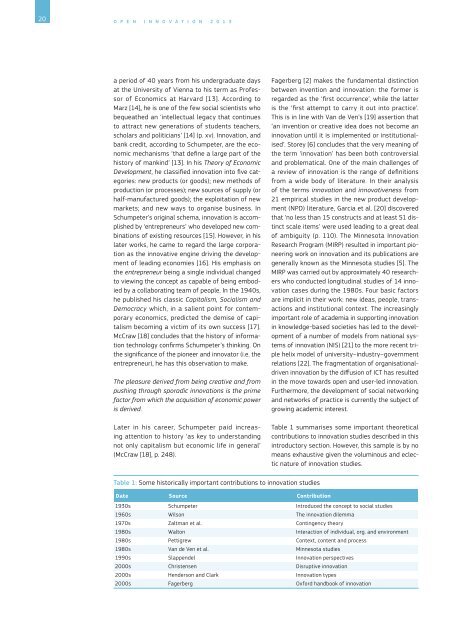Open Innovation 2.0 Yearbook 2013 - European Commission - Europa
Open Innovation 2.0 Yearbook 2013 - European Commission - Europa
Open Innovation 2.0 Yearbook 2013 - European Commission - Europa
You also want an ePaper? Increase the reach of your titles
YUMPU automatically turns print PDFs into web optimized ePapers that Google loves.
20 O P E N I N N O V A T I O N 2 0 1 3<br />
a period of 40 years from his undergraduate days<br />
at the University of Vienna to his term as Professor<br />
of Economics at Harvard [13]. According to<br />
Marz [14], he is one of the few social scientists who<br />
bequeathed an ‘intellectual legacy that continues<br />
to attract new generations of students teachers,<br />
scholars and politicians’ [14] (p. xv). <strong>Innovation</strong>, and<br />
bank credit, according to Schumpeter, are the economic<br />
mechanisms ‘that define a large part of the<br />
history of mankind’ [13]. In his Theory of Economic<br />
Development, he classified innovation into five categories:<br />
new products (or goods); new methods of<br />
production (or processes); new sources of supply (or<br />
half-manufactured goods); the exploitation of new<br />
markets; and new ways to organise business. In<br />
Schumpeter’s original schema, innovation is accomplished<br />
by ‘entrepreneurs’ who developed new combinations<br />
of existing resources [15]. However, in his<br />
later works, he came to regard the large corporation<br />
as the innovative engine driving the development<br />
of leading economies [16]. His emphasis on<br />
the entrepreneur being a single individual changed<br />
to viewing the concept as capable of being embodied<br />
by a collaborating team of people. In the 1940s,<br />
he published his classic Capitalism, Socialism and<br />
Democracy which, in a salient point for contemporary<br />
economics, predicted the demise of capitalism<br />
becoming a victim of its own success [17].<br />
McCraw [18] concludes that the history of information<br />
technology confirms Schumpeter’s thinking. On<br />
the significance of the pioneer and innovator (i.e. the<br />
entrepreneur), he has this observation to make.<br />
The pleasure derived from being creative and from<br />
pushing through sporadic innovations is the prime<br />
factor from which the acquisition of economic power<br />
is derived.<br />
Later in his career, Schumpeter paid increasing<br />
attention to history ‘as key to understanding<br />
not only capitalism but economic life in general’<br />
(McCraw [18], p. 248).<br />
Table 1: Some historically important contributions to innovation studies<br />
Date Source Contribution<br />
Fagerberg [2] makes the fundamental distinction<br />
between invention and innovation: the former is<br />
regarded as the ‘first occurrence’, while the latter<br />
is the ‘first attempt to carry it out into practice’.<br />
This is in line with Van de Ven’s [19] assertion that<br />
‘an invention or creative idea does not become an<br />
innovation until it is implemented or institutionalised’.<br />
Storey [6] concludes that the very meaning of<br />
the term ‘innovation’ has been both controversial<br />
and problematical. One of the main challenges of<br />
a review of innovation is the range of definitions<br />
from a wide body of literature. In their analysis<br />
of the terms innovation and innovativeness from<br />
21 empirical studies in the new product development<br />
(NPD) literature, Garcia et al. [20] discovered<br />
that ‘no less than 15 constructs and at least 51 distinct<br />
scale items’ were used leading to a great deal<br />
of ambiguity (p. 110). The Minnesota <strong>Innovation</strong><br />
Research Program (MIRP) resulted in important pioneering<br />
work on innovation and its publications are<br />
generally known as the Minnesota studies [5]. The<br />
MIRP was carried out by approximately 40 researchers<br />
who conducted longitudinal studies of 14 innovation<br />
cases during the 1980s. Four basic factors<br />
are implicit in their work: new ideas, people, transactions<br />
and institutional context. The increasingly<br />
important role of academia in supporting innovation<br />
in knowledge-based societies has led to the development<br />
of a number of models from national systems<br />
of innovation (NIS) [21] to the more recent triple<br />
helix model of university–industry–government<br />
relations [22]. The fragmentation of organisationaldriven<br />
innovation by the diffusion of ICT has resulted<br />
in the move towards open and user-led innovation.<br />
Furthermore, the development of social networking<br />
and networks of practice is currently the subject of<br />
growing academic interest.<br />
Table 1 summarises some important theoretical<br />
contributions to innovation studies described in this<br />
introductory section. However, this sample is by no<br />
means exhaustive given the voluminous and eclectic<br />
nature of innovation studies.<br />
1930s Schumpeter Introduced the concept to social studies<br />
1960s Wilson The innovation dilemma<br />
1970s Zaltman et al. Contingency theory<br />
1980s Walton Interaction of individual, org. and environment<br />
1980s Pettigrew Context, content and process<br />
1980s Van de Ven et al. Minnesota studies<br />
1990s Slappendel <strong>Innovation</strong> perspectives<br />
2000s Christensen Disruptive innovation<br />
2000s Henderson and Clark <strong>Innovation</strong> types<br />
2000s Fagerberg Oxford handbook of innovation
















